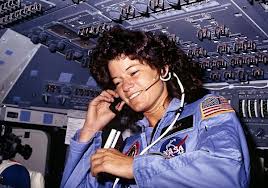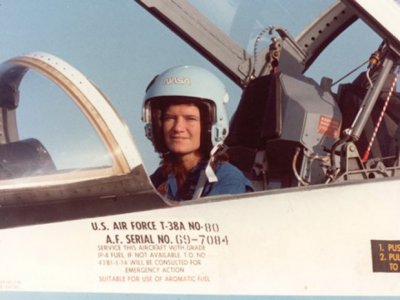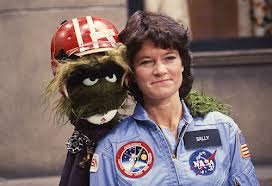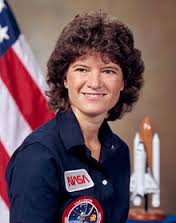Women in Space: Sally Ride

This article is the third in a series of articles in which I will profile every woman astronaut, cosmonaut and taikonaut who has been into space. Last time we looked at the career of Svetlana Savitskaya the second woman in space. Today I’m profiling astronaut Sally Ride, the first American woman in space. (The feature image above is a collection of drawings of women astronauts by artist Phillip J Bond. You can find Phillip’s wonderful series on women astronauts here.)
In 2004 I saw Sally Ride at an Australian Broadcast Corporation (ABC) Radio National Science Special in Canberra. When I first saw her speak, I was surprised how small she appeared on stage. In my mind, Sally Ride was larger than life, an adventurer, explorer, a trailblazer who broke boundaries in physics, astrophysics and space exploration. Of course within a few minutes of her speaking I was completely drawn into her world of science and space exploration where her stature, and gender is irrelevant. (The transcript of the show she shared with astrophysicist Paul Davies, and marine biologist Syliva Earle can be read here).

Sally Ride was born in Encino, California. She had one sibling, a sister, her mother was a volunteer counselor at a women’s prison, her father was a political science professor. Sally went to Swarthmore College, taking physics courses at UCLA, she then went on to Stanford to earn her Bachelors degree in English and Physics, and her Masters degree and PhD in physics. Sally was an accomplished athlete, and nationally ranked tennis player in her youth.
Sally was one of about 8,000 people who responded to NASA’s call for applicants for the space program. Sally was ‘recruited’ to NASA by actor Nichelle Nicols who played communications officer Lt. Uhura in the original Star Trek television series. NASA had asked Nichols to help them find the first qualified women and minorities to join what was was until then, an all white male astronaut corps. After more than 12 months of testing and training Sally was one of the few selected to join NASA in 1978. Somewhat unsurprisingly at the time, her gender attracted quite a bit of media attention. Although she herself stayed well clear of gender issues Sally was still asked inane questions like ‘Do you weep when things go wrong on the job?’, and ‘Will the flight affect your reproductive organs?’. Sally noted that she felt astronaut training was ‘asexual’, women and men did all the same training, and that in space ‘weightlessness was the great equaliser, you don’t need to be strong in space’.

When Challenger roared into space on 18 June 1983 Sally Ride became the first American woman, and the youngest astronaut in space. She was preceded by Valentina Tereshkova in 1963 and Svetlana Savitskaya in 1982, both Russian astronauts. During the STS-7 mission the crew deployed two communications satellites and conducted pharmaceutical experiments. Sally was the first woman to use the robot arm in space and the first to use the arm to retrieve a satellite. Sally’s second space flight was in 1984, STS-41G where the crew deployed the Earth Radiation Budget Satellite, and conducted various observations. STS-41G was the first time that two women flew in space together, when Kathryn Sullivan joined Ride on the crew. Upon her return she was then scheduled for STS-61M, however, that mission was cancelled in the wake of the Challenger disaster. She was nominated to head the Operations sub-committee on the Rogers Commission, the presidential commission investigating the challenger accident. Following the investigation Sally went to work in NASA HQ authoring a report ‘NASA Leadership and America’s Future in Space’.

During her career, Sally served as the ground-based capsule communicator (CapCom) for the second and third Space Shuttle flights (STS-2 and STS-3) and helped develop the Space Shuttle’s robot arm. She spent a total of more than 343 hours in space. Sally remarked in an 1984 interview that she felt ‘a lot of pressure’ being the first US woman in space, and that most of the pressure was ‘generated by the media’. She said she felt ‘proud’ to be the first US woman in space, and that the extra pressure made her determined to do things right.
Sally left NASA in 1987 and went to work for Standford University, she then moved to the University of California San Diego (UCSD) as the Professor of Physics. She was also the Director of the California Space Institute, and a vigorous promoter of public outreach for science. In 2001 Sally co-founded her own company, Sally Ride Science, a company that creates entertaining science programs, events, and publications for elementary and middle school students, with a focus on girls. In 2003 she was asked to be a member of the Space Shuttle Columbia Accident Investigation Board, the only person to sit on both the Challenger and Columbia accident boards. Whilst at USCD, Sally led Jet Propulsion Laboratories (JPL) public outreach program for the ISS – EarthKAM and GRAILMoonKAM which encouraged school students to study imagery of the Earth and moon. Sally was also nominated to serve on the 2009 commission that helped shape NASA’s current spaceflight program.

Sally Ride passed away on 23 July 2012 from pancreatic cancer. A fiercely private person, she did not release any information or details of her 17 month battle with her illness. Her death shocked many people. President Obama said shortly after her death ‘As the first American woman to travel into space, Sally was a national hero and powerful role model. She inspired generations of young girls to reach for the stars and later fought tirelessly to help get them there by advocating for a greater focus on science and math in our schools’. Sally’s legacy of public outreach and work with school students through her company Sally Ride Science will be continued by her partner and co-founder of Sally Ride Science, Tam O’Shaughnessy.
Perhaps the most moving tribute to Sally comes from her friend Nichelle Nichols, ‘Sally Ride — my heart aches right now. Sally was one of my first and biggest achievements. She once thanked me for my recruitment efforts while under contract to NASA, saying “If it hadn’t been for you I might not be here.” Sally carved out her own place in history as the first American woman in space, but she was much more than that. She was a symbol for all of the little girls that needed to see what was achievable if you worked hard and studied hard. Sally was a physicist and had a love for the Sciences – a field of study that we should all encourage young people to follow. Many people have said that I was their inspiration, something that fills my heart with joy every time that I hear it. When NASA asked me to help them find the first qualified women and minorities to join the then all-male-all-white astronaut corp, I did so with great enthusiasm. One of the first that my company was able to reach was a beautiful, young, brilliant woman named Sally Ride. She not only joined the astronaut corps – she revolutionized it by blazing the trail that so many female astronauts followed. She became MY inspiration to continue to search to find the next Sally Ride, or Dr. Mae Jemison. I know that right now there’s a little Sally or Mae out there, reading about what Sally achieved in her life, and deciding that Mars sounds like a great place to visit……..Dream On! Sally will lead the way!
 Follow
Follow
3 thoughts on “Women in Space: Sally Ride”
Comments are closed.